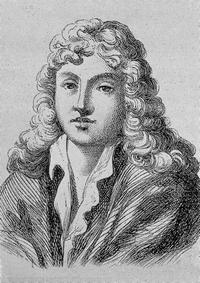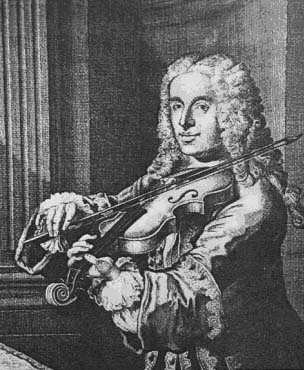<Back to Index>
- Lexicographer and Cryptographer Johannes Trithemius, 1462
- Composer Francesco Maria Veracini, 1690
- 12th Prime Minister of Canada Louis Stephen St. Laurent, 1882
PAGE SPONSOR


Francesco Maria Veracini (1 February 1690 – 31 October 1768) was an Italian composer and violinist, perhaps best known for his sets of violin sonatas.
Francesco Maria Veracini led a turbulent life. Born in Florence, the son of a pharmacist and undertaker, he was taught the violin by his uncle, Antonio Veracini, with whom he often appeared in concert. Veracini wrote a concerto grosso for eight instruments which was performed in 1711 at the coronation festivities for the Emperor Charles VI.
There is a legend that, when Giuseppe Tartini heard Veracini playing the violin in 1712, he was so impressed by his bowing technique, and so dissatisfied with his own skill, that he retreated the next day to Ancona "in order to study the use of the bow in more tranquility, and with more convenience than at Venice, as he had a place assigned him in the opera orchestra of that city".
In 1714 Veracini went to London and played instrumental pieces ("symphonies" in contemporary parlance) between the acts of operas at the Queen's Theatre. After a season at the court in Düsseldorf and once again in Venice in 1716, he wrote a set of violin/recorder sonatas dedicated to Prince Friedrich August (who in 1733 would become Augustus III of Poland and Augustus II Elector of Saxony). The Prince was in Venice recruiting musicians on behalf of his father Augustus II the Strong/Augustus I for the Saxon Court in Dresden. At the Prince's urging, Augustus the Strong employed Veracini to play chamber music at his court, later transferring him to the official Dresden payroll as violinist in August 1717. Veracini was sent to recruit Italian singers for the Dresden opera. In 1721 Veracini wrote another set of violin sonatas dedicated to the Prince (published as his Opus 1).
Unfortunately, there was animosity among the musicians at the court in Dresden. Veracini was involved in 1722 in a quarrel, staged according to one source by the composer and violinist Pisendel, which resulted in Veracini leaping out of an upper-story window. He walked with a limp for the rest of his life. Back in his native Florence in 1723, Veracini played music in a church and wrote an oratorio. During this time he earned a bad reputation and was said by Charles Burney to have been "usually qualified with the title of Capo pazzo" ["head lunatic"].
Back in London in 1733, Veracini appeared in many concerts. There he wrote an opera, Adriano in Siria, considered too long by the music critics. In 1737, he wrote La Clemenza di Tito, on a libretto by Corri based on one by Pietro Metastasio. (The Metastasio libretto was also the basis of the one Mazzola wrote for Mozart's La Clemenza di Tito). In 1738 Veracini wrote his third opera, Partenio, and in 1744 his last opera, Roselinda, based on Shakespeare's play As You Like It, a most unusual choice of material at that time. In that opera Veracini included the well-known Scots ballad tune The Lass of Paties Mill. It was staged in London in 1744, the same year his oratorio (described as an opera in Burney 1789) L'errore di Salomone was staged, and its lack of success (Burney scorned the music as "wild, awkward, and unpleasant; manifestly produced by a man unaccustomed to write for the voice", but confessed that "This opera, to my great astonishment when I examined the Music, ran twelve nights", whereas L'errore di Salomone was given only twice) prompted Veracini to leave London a little more than a year later.
After surviving a shipwreck in the English Channel, he again returned to Florence, where he was appointed maestro di capella of the churches of San Pancrazio and San Gaetano, the latter one at which his uncle had worked, focusing on church music. Though he mostly conducted in his later years, he still sometimes appeared as a violinist. He died in Florence.
In addition to violin sonatas, operas and oratorios, Veracini also wrote violin concertos, sonatas for recorder and basso continuo, and orchestral suites, called Overtures. The six Overtures were performed for Prince Friedrich August in Venice in 1716, as part of Veracini's ultimately successful attempt to secure a position at the Dresden court. They are all either in F major or B-flat major, except for one in G minor. The last one of these, in B-flat major, is remarkable for concluding with a unison minuet. Veracini also wrote a "lively, highly original theory treatise", Il trionfo della pratica musicale, and edited other composers' works, adding "improvements" of his own, such as he did in his Dissertazioni with the Opus 5 Violin Sonatas of Arcangelo Corelli.